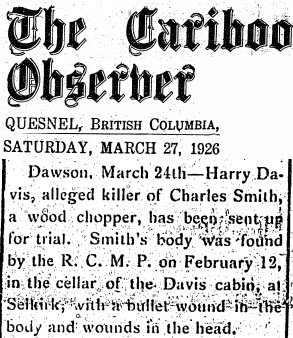This twelve instalment of the true crime stories of Convicts buried in the Boot Hill Cemetery, New Westminster, B.C., is unique. Not only were there no witnesses to the crime, but the suspect hid the body in his cellar! Want to know more? Join me on this journey of discovery.
Meet Convict #3130 - Harry Davis
 |
| Courtesy Find a Grave - photo: Herbert Richards (2007) - Middle Section, North edge of Ravine |
We first learned about Harry Davis in the newspapers by accident. The news reported our convict's fate under the name of "Henry Davis". However, further research confirmed that this was our man.
 |
| Courtesy Newspapers.com - Winnipeg Tribune (Mar09, 1926) pg 8. |
 |
| Courtesy Newspapers.com - Ottawa Journal (Mar09, 1926) pg 14 |
 |
| Courtesy Yukon Register of Historic Places - Fort Selkirk today |
 |
| Courtesy Google Maps - Yukon Territory, Canada |
 |
| Courtesy UBC Library Open Collections - RCMP Report 1926 |
With this news, the Constable and Menzies continued down river to Charles' cabin on one of the many small islands. Charles had trap lines on the shoreline, so the men followed them over the next 3 days, covering approximately 50 square miles. They found one clue. Charles had a calendar hanging on the wall in his cabin with all the dates crossed off, up to and including February 12th, 1926. Thornthwaite knew Smith to cross the dates off each morning, so his belief was that the wood chopper had been there the morning of the 12th. With this information in mind, the Constable knew he must have gone missing directly after, and since Harry Davis had seen him on that same day, there was more to tell to his story. The men decided to go back to visit with Harry Davis and ask more questions.
On March 7th, 1926, Constable Thornthwaite and Mr. Menzies arrived back at Harry's log cabin with their dog teams. While Menzies took a poke around the forest and the outside of the cabin for tracks and signs of disturbance, the Constable went inside to talk with Davis. Thornthwaite decided to take it easy, but soon had their discussion back directed back on Davis' last sighting of Smith. Harry described the wood chopper had been wearing a dark flannel shirt, a leather belt with Colt Automatic attached, and wore a dark blue toque, Indian moccasins, with an US Army issued khaki rucksack. Thornthwaite then noticed Davis' calendar had all dates crossed off but February 12th. Something must have occurred on that date to upset Harry's routine.
Thornthwaite stated his visit was a reason to file Davis' claim for welfare rations, and asked if he could search the cabin to ensure his claim was truthful. Harry provided permission and explained he'd not had meat all winter because he couldn't afford the cost of ammunition. This was different from what Davis explained during their prior visit. Davis remained in the centre of the cabin during the search; then Thornthwaite asked him to step back. He found what could have been a blood stain on the wooden floor, and questioned Harry further. Then he uncovered a crack in the dirt and sand on the floor. It was the trapdoor to the cellar. Davis became nervous, stated he'd not been in the cellar for months, but the Constable pried open the door. Harry Davis attempted to grab his rifle, but Menzies, who had come into the cabin with nothing to report, pointed his gun at Harry's chest. With this Harry admitted to killing Charles Smith. Thornthwaite spotted a pair of legs below and climbed down into the cellar to discover Charles' body. His head had been bashed in, with a bullet wound to the chest. His revolver was missing but there was over $400 dollars in his pocket.
Harry Davis was formally arrested that day.
 |
| Courtesy Yukon Archives-photo: Thornthwaite, Harry Davis, Assess.No. 297.YA.83-22.51 |
Harry Davis was taken to Fort Selkirk where he was kept at the back of the General Store to be monitored. The following day Joe Menzies and another man returned to the cabin to retrieve Charles Smith's body. A week later Constable Thornthwaite and Constable J. R. Purdue (from Whitehorse) delivered Harry Davis and Charles' corpse to the Dawson City jail via Royal Mail Stage Coach.
 |
| Courtesy Yukon Archives-photo: Myers, Dawson Court House, Assess No. 462.YA.93-142.12 |
 |
| Courtesy Yukon Archives-photo: Walmsley, Dawson Jail, Assess No. Assess No. 351.YA.10404 |
 |
| Courtesy Yukon Archives-photo: Claude Tidd, Dawson 1930's, Assess No.Assess No. 74.YA.8351 |
 |
| Courtesy Quesnel Museum - Cariboo Observer (Mar.27, 1926) |
The story is not finished. On March 5th, 1927, Harry Davis died of "Acute Congestion of Lungs, Exposure (self-inflicted)".
On March 7th, 1927, a Coroner's Inquest was held. Warden Herbert Walters Cooper testified that Harry Davis was feigning insanity so he would be transferred to a Provincial Mental Hospital. On the evening of March 4th, Dr. Green and Warden Cooper agreed to have Davis transferred into an isolation cell (perhaps as punishment - this is not confirmed), both visiting with him over a 12 hour period. They noticed Davis had removed all his clothing; however, neither was concerned indicating the temperature of the cell was "unusually warm". The Warden's testimony stated the inmate was possibly suicidal; although the Doctor's testimony did not concur with this. Not quite 12 hours later, the Coroner received word from the Night Keeper indicating there was something wrong. When Dr. Green arrived at the penitentiary, Davis was laying under a heap of blankets, his body freezing, his breath shallow and his pulse unusually slow. Davis was removed from the cell, brought to the kitchen and laid next to the stove surrounded by hot water bottles. In spite of this, Harry Davis died a few hours later.
The Coroner's Jury ruled that Harry Davis died at 5 a.m. on March 5, 1927, in the Penitentiary Hospital as a result of acute congestion of the lungs brought on by him exposing himself.
At a post-mortem examination it was found that Harry Davis had been suffering from a small brain tumor which may have influenced his mental condition.
 |
| Courtesy FamilySearch.org - Harry Davis death certificate, Mar.05, 1927 |
To understand a bit more about Harry Davis and why he ended up in the Yukon Territory, we turn to his death certificate and the information it provides:
Birth: June 10, 1877
Birthplace: Ontario
Status: Widowed
Occupation: Cook, Cooking
Racial Origin: English
No names are listed for Father and Mother.
A listing was found of a Harry Davis living in "Moosehide", and "Carcross" in the Yukon Archives Genealogy Database, but no date was given.
Moosehide is a Heritage Settlement of the Tro'ndek Hwech'in First Nation situated approximately 5 kms (3.1 mil) downriver from Dawson. Cabins were built around 1897, along with a church and house for the resident Anglican missionaries. The village was also used to house different First Nation bands of the Territory when they arrived at Dawson for trading purposes.
Carcross is 74 kms (46 mi) south-southeast from Whitehorse. It is home to the Carcross/Tagish First Nation, and was once known as Caribou Crossing (renamed in 1904). It became a popular stop for prospectors during the Klondike Gold Rush.
Could Harry have spent some time in both places? Perhaps. There were many camps in both areas in the late 1800's to early 1900's where he may have been employed as a cook.
Records from B.C. Penitentiary indicate he was born in Peterborough, Ontario, and was a widower with two children. Harry was not located on any Canada Census that would match what we know about him; and without further information to assist us (i.e.: father's name), records are difficult to find or are just not available.
 |
| Courtesy Google Maps - Peterborough, Ontario and Fort Selkirk, Yukon Territory |
 |
| Courtesy Ancestry.ca - 1921 Canada Census, Fort Selkirk & River Points |
The 1921 Canada Census also confirms a Joseph H Menzies, 40 years old, single, miner, Canadian of English origin, had lived in Fort Selkirk, Yukon. No further information was found.
 |
| Courtesy Yukon Archives-photo: Thornthwaite, 1920s, the Constable, Assess No.Assess No. 356.YA.83-22.44 |
 |
| Courtesy Yukon Archives-photo: Thornthwaite, Arrival in Yukon, WP&YR Rail, Assess No.Assess No. 289.YA.83-22.2 |
 |
| Courtesy Yukon Archives-photo: Thornthwaite, with lead dog Allie, Assess No. 315.YA.83-22.237 |
 |
| Courtesy Ancestry.ca - Victoria Times Colonist 1996 |
If you have not read any of our previous accounts, please check them out. Each convicts' story is filled with interesting facts, incredible adventures and emotional effect.
01) Meet Convict 1548 - Thompson
02) Meet Convict 2370 - Walsh
03) Meet Convict 2304 - Chinley
05) Meet Convicts 1628 - Herman Wilson + Unknown# - Joseph Smith
06) Meet Convict 1659 - Y. Yoshie
07) Meet Convict 1884 - Moses Paul
08) Meet Convict 2516 - Daniel Henrick Urick
09) Meet Convict 1948 - Unknown Gim
10) Meet Convict 2938 - Reginald John Colpitts
11) Meet Convict 5603 - Stephen Poole
12) Meet Convict 3130 - Harry Davis
13) Meet Convict 2312 - Albert Hill
14) Meet Convict Unknown# - Phillip Hopkins
15) Meet Convict #9720 - Norman Donald Bottineau
16) Meet Convict #2225 - Louie Num
17) Meet Convict #3237 - Harold Gordon McMaster
18) Meet Convict #4234 - Herbert Ross
19) Meet Convict #9693 - W. Black
20) Meet Convict #6651 - Gordon Wallace
21) Meet Convict #9511 - Henry Gordon Wichmann
22) Meet Convict #3348 - Frank Wilson
20) Meet Convict #6651 - Gordon Wallace
21) Meet Convict #9511 - Henry Gordon Wichmann
22) Meet Convict #3348 - Frank Wilson
Thank you for joining us. If you have comments to share, questions to ask, or simply are curious, please join us at our Facebook Page, or contact us via our Website. We'd love to hear from you!
Until next time,
Kati
Sources: BC Archives; Yukon Archives; McBride Museum; Google Maps; "Nine Dog Winter: The Body Below" - Bruce T Batchelor; 21stBattalion.ca; Virtual Museum of Canada; Library and Archives Canada; B.C. Penitentiary Collection - blog; "Four Walls in the West" - Jack David Scott; Newspapers.com; Ancestry.ca; FamilySearch.org; YukonHistoricPlaces.ca; Quesnel Museum; Vancouver Public Library; Wikipedia; the Canadian Encyclopedia; Explore North; UBC Library Open Collections; Find A Grave; Trondek Heritage; Ontario Genealogy.














No comments:
Post a Comment